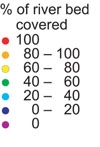Water resources in summer 2002–03
River flow
River flows over last summer were below normal or near normal for much of the country. After a fairly damp December in some places, flows reached record low values in February in parts of central and southern North Island, Nelson, and central Canterbury.


Water clarity
Streams were much clearer than usual for this time of year in the southern North Island and upper South Island, as a result of the low flows, with very few floods to stir up river sediments.




Slime index
The slime index records the cover of the bed by “nuisance” slimes (algae growing as thick mats or filamentous growths) that reduce the recreational and aesthetic value of the river if too prolific (i.e., cover > 30–60%). Slimes are encouraged by warm temperatures, sunlight, nutrients (especially nitrogen and phosphorus), and lack of floods. Maximum values were generally low this summer.


Water temperatures
Stream temperatures were up to two degrees cooler than normal last summer, mostly as a consequence of the cool air temperatures.




Lake levels

Lake levels across most of New Zealand were near normal, or below normal. For many lakes, the levels are a reflection of recent weather. However, for lakes that are managed for uses such as hydro-electric power generation or irrigation, the levels also depend on how the lake is managed. For example, water can be stored during times when inflows are large, and released later, when demand is greatest. Exactly how this is done depends on the timing of the inflows, the patterns of demand for water, and the operating rules for managed lakes.
This page summarises a variety of water resources data for the period Dec 2002 to Feb 2003. Note that the data are preliminary, and subject to amendment after quality assurance procedures. We thank NIWA field teams, regional and district councils and hydro-power companies for providing this information. We hope to expand the coverage with contributed measurements using standard methods at long-term sites.
For information on hydroelectricity storages, see COMIT Free To Air.
